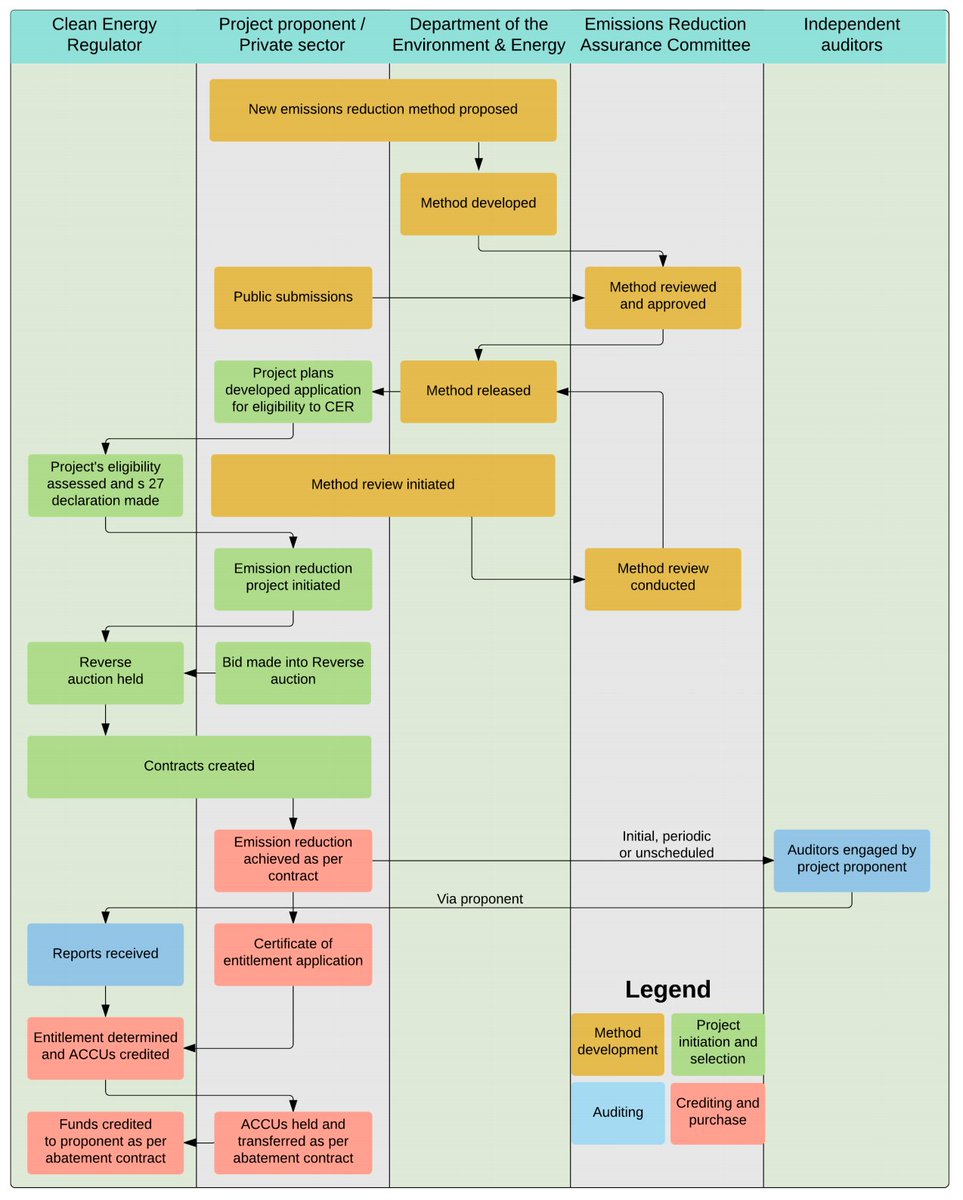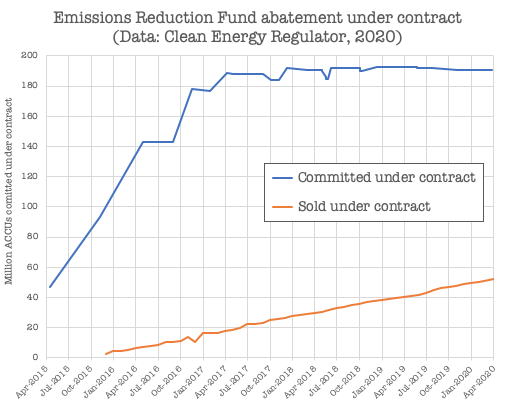The Emissions Reduction Fund (ERF) will turn five in the next fortnight. So this might be a good time to dig into what it has achieved in that time, and highlight some of the failings.
But first, a quick overview of the scheme:
But first, a quick overview of the scheme:
The ERF is a modified version of the ALP& #39;s Carbon Farming Initiative, and almost everything about the scheme is identical to what it was under the ALP.
Where tweaks have occurred, they have been pretty minor changes, even if those changes had big effects.
Where tweaks have occurred, they have been pretty minor changes, even if those changes had big effects.
The Carbon Farming Initiative was designed to provide an alternative way for those who were covered by the carbon price to meet their obligations.
Rather than buy allocations from the government at ~$25 per tonne, big emitters could pay others to avoid or draw down emissions.
Rather than buy allocations from the government at ~$25 per tonne, big emitters could pay others to avoid or draw down emissions.
Then the carbon price died. Vale.
The ERF sees the burden of buying abatement (emissions reduction and drawdown) shift from big emitters to the Federal Government.
The Feds allocated $2.55b to start with. And from the main allocation, $2.33b is earmarked for specific projects.
The ERF sees the burden of buying abatement (emissions reduction and drawdown) shift from big emitters to the Federal Government.
The Feds allocated $2.55b to start with. And from the main allocation, $2.33b is earmarked for specific projects.
The way it works:
1) Register for the ERF.
2) Win a contract (This can happen whenever, but as (2) it is most logical.)
3) Do your abatement activity.
4) Get ACCUs for doing the thing.
5) Sell ACCUs back to the Government at the price you offered in your auction bid.
6) Profit?
1) Register for the ERF.
2) Win a contract (This can happen whenever, but as (2) it is most logical.)
3) Do your abatement activity.
4) Get ACCUs for doing the thing.
5) Sell ACCUs back to the Government at the price you offered in your auction bid.
6) Profit?
The $2.33b allocated so far is earmarked for 486 different projects around the country under 27 different methods.
The proponents of these projects all bid into, and were successful in, one of ten reverse auctions held by the Clean Energy Regulator.
The proponents of these projects all bid into, and were successful in, one of ten reverse auctions held by the Clean Energy Regulator.
(A reverse auction is like a normal auction, but you win if you have an acceptably low bid. These auctions have been held around twice a year.)
The Federal Government announced an additional $2b for the ERF in the lead-up to the last election. No-one has seen that money yet.
The Federal Government announced an additional $2b for the ERF in the lead-up to the last election. No-one has seen that money yet.
The total quantity of abatement committed to the ERF has stayed basically the same since 2017. The first five auctions saw big jumps in contracted abatement, up to ~190 million ACCUs.
Since then, the auctions have mostly been about replacing failed projects in the portfolio.
Since then, the auctions have mostly been about replacing failed projects in the portfolio.
Most projects deliver ACCUs to the Government over a period of seven or ten years.
An ACCU is an Australian Carbon Credit Unit. This is the currency of the ERF. It is a certificate that is notionally equivalent to 1 tonne of carbon dioxide not in the atmosphere.
An ACCU is an Australian Carbon Credit Unit. This is the currency of the ERF. It is a certificate that is notionally equivalent to 1 tonne of carbon dioxide not in the atmosphere.
The word & #39;notionally& #39; is doing a lot of heavy lifting there, though.
There are a lot of projects in the ERF that *definitely* shouldn& #39;t be. Under the third largest method of the ERF (landfill gas), most ACCUs provide no verifiable benefit to the climate. https://theconversation.com/the-government-is-miscounting-greenhouse-emissions-reductions-88950">https://theconversation.com/the-gover...
There are a lot of projects in the ERF that *definitely* shouldn& #39;t be. Under the third largest method of the ERF (landfill gas), most ACCUs provide no verifiable benefit to the climate. https://theconversation.com/the-government-is-miscounting-greenhouse-emissions-reductions-88950">https://theconversation.com/the-gover...
The total contracted by the ERF is 191 million ACCUs which are notionally equivalent to 191 million tonnes of avoided or drawn-down emissions to be delivered over a total of 15 years.
That& #39;s an average of 12.7 million tonnes per year even if an ACCU is equal to 1 tonne.
That& #39;s an average of 12.7 million tonnes per year even if an ACCU is equal to 1 tonne.
Australia emitted 530 million tonnes of (CO2 equivalent) of greenhouse gas last year, so at best the ERF reduced our emissions by less than 2.5%.
That& #39;s fine until you realise that the point is to be at zero emissions ASAP, and our big emitters have increased unconstrained.
That& #39;s fine until you realise that the point is to be at zero emissions ASAP, and our big emitters have increased unconstrained.
To get a sense of the different methods, you should check out https://offsetsmonitor.org.au/ ">https://offsetsmonitor.org.au/">...
This website (of mine) is one year out of date (sorry!), but is intended to open up data on the ERF so you can see what& #39;s going on.
Unfortunately, it& #39;s also a pain to update.
This website (of mine) is one year out of date (sorry!), but is intended to open up data on the ERF so you can see what& #39;s going on.
Unfortunately, it& #39;s also a pain to update.
There is a tonne of good journalism that interrogates the ERF. I commend you to flick through the work of @adamlmorton, @nicole_hasham, @MikeySlezak and @peterhannam on this, among several others.
For example, see: https://www.google.com/search?q=%22Adam+Morton%22+%22Emissions+Reduction+Fund%22">https://www.google.com/search...
For example, see: https://www.google.com/search?q=%22Adam+Morton%22+%22Emissions+Reduction+Fund%22">https://www.google.com/search...
If you want to play with the up to date data, albeit in a far uglier form than the offsets monitor website, type http://35.189.56.28 into your browser.
That is the proof of concept website that offsets monitor was built on and it is up to date.
That is the proof of concept website that offsets monitor was built on and it is up to date.
If you really want to get into the weeds on the ERF, I strongly recommend this article as an intro.
I know the lead author. He is legend. https://www.dropbox.com/s/rpf6e54swopooot/2.pdf?dl=0">https://www.dropbox.com/s/rpf6e54...
I know the lead author. He is legend. https://www.dropbox.com/s/rpf6e54swopooot/2.pdf?dl=0">https://www.dropbox.com/s/rpf6e54...

 Read on Twitter
Read on Twitter





